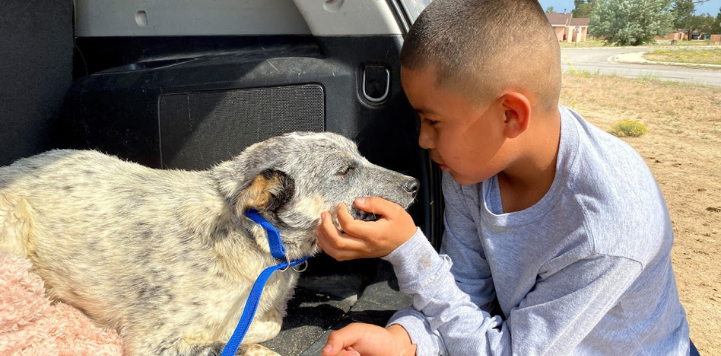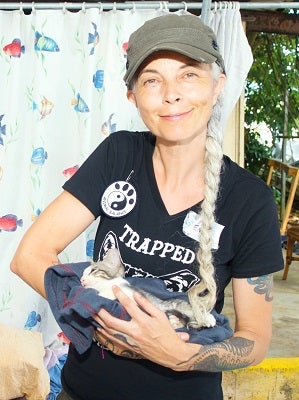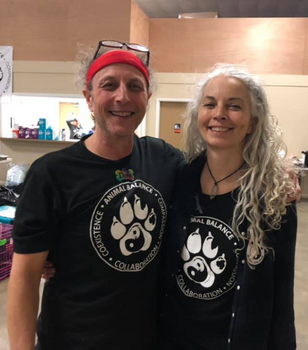
Reconsidering your mission (Part III): An interview with Animal Balance
Over the past two weeks, we heard from organizations whose work shifted over time to address urgent needs in their communities. This week, we talk with Emma Clifford, founder and executive director of Animal Balance, about how the pandemic led her international non-governmental organization (NGO) to turn its attention to solving problems on American shores instead.
Animal Balance was founded in 2004 after Emma’s discovery during a visit to the Galapagos Islands in Ecuador that the population of cats and dogs was being “managed” with rat poison. It took a year of asking, but the Galapagos National Park Service finally allowed Emma to deploy a high-quality, high-volume spay/neuter (HQHVSN) clinic that she developed with Julie Levy, DVM, Fran Marino Professor of Shelter Medicine Education at the University of Florida. It not only worked better than killing community pets, but by 2008 over 80% of the cat and dog populations on the islands Santa Cruz, San Cristobal, Isabela and Floreana had been sterilized.
Since then, Animal Balance has been bringing HQHVSN to communities on a dozen island nations in service of its mission “to create sustainable and humane animal management programs in order to prevent suffering and ignite social change.”
As an organization with an international focus, Animal Balance faced a unique challenge during the pandemic. Although U.S. shelters and spay/neuter clinics had to make major adjustments because the public could no longer enter their facilities, at least work could carry on behind those closed doors. You guys were kind of stuck in place.
True, but Animal Balance has a database of more than 2,500 people who are well-trained in running large-scale, MASH-style HQHVSN events. Not only did they want to keep working, but many of them embraced the #vanlife trend. We have been able to take advantage of the movement where some vets don’t want to be associated with just one place, they want to be free to work in a variety of locations.
The goal is for every shelter to have at least one part-time or full-time veterinarian, but that’s not where our industry is at right now. When we saw spay/neuter clinics shut down, we all knew what that was going to mean. Over-capacity, under-resourced shelters already had long spay/neuter waiting lists. No one wanted the backlogs to get bigger.
Absolutely. That was a huge fear in the early days of COVID. So, I know you reached out to Best Friends to find out where the data showed the greatest need.
Yes, and we’ve been deploying teams to shelters in Texas and Louisiana ever since. We are also working with indigenous communities in Arizona and New Mexico.
 We do three-day clinics and our targets are 100 surgeries with a one-doctor team or 200 surgeries with a two-doctor team. But we don’t just do spay/neuter; we also teach our partners “The Art of MASH,” if you will. HQHVSN teams can be much more efficient and productive if the receiving shelter has a well-trained support team, so we teach shelters how to have those teams in place.
We do three-day clinics and our targets are 100 surgeries with a one-doctor team or 200 surgeries with a two-doctor team. But we don’t just do spay/neuter; we also teach our partners “The Art of MASH,” if you will. HQHVSN teams can be much more efficient and productive if the receiving shelter has a well-trained support team, so we teach shelters how to have those teams in place.
We also can be a bridge for shelters and vets. Shelters are struggling to attract and keep veterinarians for a lot of reasons. We don’t have that same problem. In fact, the Animal Balance culture can help shelters overcome the concerns that vets sometimes have.
We don’t just pull together teams of vets and techs, there’s a certain kind of culture that exists at Animal Balance. We’ve all worked in difficult situations together with few resources, so that builds a strong sense of trust. The vets and techs also trust us in terms of where we choose to go because they know we've done our homework first. We never go to pretty islands just because they're pretty islands. We go because there’s a critical reason to go.
Lastly, we are always extremely excited and enthusiastic about our clinics. That attitude is infectious and pretty soon our partner organization sees the light at the end of the tunnel.
I think a lot of network partners are likely to be excited about the idea of having Animal Balance alleviate some of the backlog they have in surgeries or be the entrée into a more permanent relationship with vet resources. The big question, of course, is “How much do these clinics cost and where does the money come from?”
Animal Balance’s vets and techs get paid a competitive daily rate that reflects their incredible skill and value. That’s between $500 and $800 a day for vets and between $150 and $200 a day for techs. They also get vegan lunches and accommodations as part of the package. Where those funds come from has become more complex during the past few years.
Everybody thinks that paying for spay/neuter should be like it's always been, where we all get lots of grants and go off and do our work. It's just not like that anymore. Today, foundations have reduced their support of humane population control of cats and dogs in favor of programs designed to care for the puppies and kittens who have already been born.
Yeah, spay/neuter has never been really “sexy” in terms of motivating donations.
Many, if not most, animal welfare grant programs serve what happens after the puppies and kittens are born. Cute and cuddly pictures are hard for HQHVSN groups to compete with. MASH clinics are not cute. They are hard work, require specific skill sets and take a lot of determination and focus.
We are fanatical about spay/neuter but there's a good reason why: it solves the problem. If we stop the endless breeding cycle, we will not have to fund the (more expensive) outcome of dealing with an overpopulation of cats and dogs. Unfortunately, today it seems that the funders are most interested in backing transport programs that often don’t include a component of turning off the tap.
So, if the traditional animal funding sources are focused on other programming, where is the money coming from to keep providing spay/neuter?
 We are probably going to start doing workshops on how spay/neuter clinics can create business models so that they can remain up and running. I can't see another way because it seems like it's a harder road to convince the foundations to put funding into spay/neuter than it is to say, OK, everyone, we're going to teach you how to do a business model.
We are probably going to start doing workshops on how spay/neuter clinics can create business models so that they can remain up and running. I can't see another way because it seems like it's a harder road to convince the foundations to put funding into spay/neuter than it is to say, OK, everyone, we're going to teach you how to do a business model.
That involves deciding what the price point is that people can afford, as well as deciding who you are going to serve. Do you want to serve the community directly or come in at the shelter or nonprofit level? Where do you want to go in and turn off the tap? Also, where do your veterinarians want to do the work? Will they want to go into a shelter or will they want to work in a converted house down the road and sleep next door?
For those that are nonprofits moving into the business world, they have to be transparent and ask for what they need to cover costs and that includes overheads. And that's OK.
We also are exploring funding from the corporate world. That is an entirely new approach for Animal Balance and quite honestly, it’s uncomfortable for us. But it’s necessary.
What other fundamental changes do you think are necessary in the country right now to help move us past the current challenges surrounding access to spay/neuter?
I’m a broken record on the need for a national vet license. Part of the reason why we’re putting a lot of effort into Texas shelters is because the state has temporary vet licenses.
A national license is particularly important for HQHVSN because there’s a short lifespan for these incredibly talented, specialized vets and technicians, who are all currently underpaid and under appreciated. It's really hard work, they develop overuse injuries and the job physically burns them out.
We also need more HQHVSN technicians, and we're training as quickly as we can, and we are working on getting certified for continuing education units. That gives people an extra incentive to work with us and it elevates their status.
The other big thing I’d like to see shelters consider is the use of megestrol acetate as a contraceptive for cats. Megestrol acetate is a tasteless, odorless powder that is easy to give in food and prevents pregnancy for up to eight months.
It requires a veterinarians’ prescription and monitoring, so I talk to shelters all the time about getting their medical director on board and I share the paper written about it by Mike Greenberg, DVM. But there is still a lot of fear about using a something new, and everyone prefers to do surgical sterilization.
Surgery is always the end goal and I absolutely agree with that. In the meantime, we shouldn’t be afraid to use every tool we have. Megestrol acetate is not a replacement for surgical sterilization; it is a tool to buy time until you can arrange for such surgery.
The push to use this tool needs to come from the veterinary community. Dr. Levy is a proponent of it; so is Alliance for Contraception in Cats and Dogs, which is currently doing a pilot “kitty birth control” program with Cat Adoption Team. But it’s not getting the push it needs in this country right now.
To help gain acceptance, we also are launching the CAT-traception Program to teach shelters and non-profits currently without HQHVSN vets and techs how to use the product.
This is a broad question, but to wrap up: what’s next for you?
Until these past few years, I'd focused our work internationally, now I see how Animal Balance could be incredibly useful in this country. We’re quite small but mighty. I wasn't thinking about getting any bigger, much less running a national organization, but the number of animals in need is enormous. If we can get the right veterinary resources to where they are needed, we can turn off the breeding tap.
I think we're at the last phase of global mass killing of cats and dogs. Maybe that's just me being grandiose here, but I think it will happen in 10 years’ time as long as we keep funding spay/neuter surgeries and exploring other ways to ensure animals are not breeding. Those pieces are absolutely critical.

Liz Finch
Senior Writer
Best Friends Network
If you enjoyed this program spotlight, you can find our complete catalog of spotlights here.